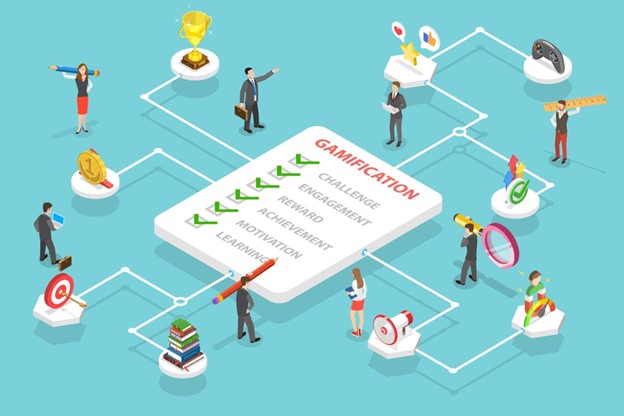
Gamification in vocational education and training
SUKH SANDHUGamification in vocational education and training
The use of gamification in vocational education and training (VET) has received increasing attention in recent years. The rationale for this is the fact that games offer a highly engaging and motivating medium with which to engage learners.
There is now considerable evidence to suggest that gamification can be successfully applied to a wide range of learning tasks and content areas, from Information technology, mechanics, mathematics and science to social and behavioural sciences to almost every other subject. This suggests that there is potential for VET curricula to be supplemented by game-based elements, with the aim of enhancing student engagement and motivation.
In this article, we will provide an overview of the current state of gamification in VET, before exploring some of the potential benefits that can be derived from its use. We will also provide a case study of how a gamified learning platform has been successfully used to motivate students.
What is gamification?
Gamification is a process of making something enjoyable in order to encourage people to do it. It's a way to get people to do something they might not want to do (lose weight, learn English, save money) by making it interesting. There are many different ways to gamify something, but the most common way is to make something into a game. By incorporating elements of gameplay into learning, educators can make the learning process more engaging and fun.
One example is weight loss programs that give participants points for every kg they lose. Those points can then be traded in for rewards like discounts at the gym or benefits like lower insurance rates. Another example is online games like World of Warcraft, where players can achieve goals like level up, find rare items, and join powerful clubs.
There are many different types of games, so it's important to choose the right one for your application. Some common things to look for when choosing a game are how customisable it is, how much fun it is to play, and how addictive it is.
The benefits of gamification in vocational education and training
There are many benefits to incorporating game-inspired design into vocational education and training (VET). Gamification can help learners identify with the challenges of the game and invest time and effort to achieve success. It can also improve motivation and engagement, as well as produce better learning outcomes. In addition, it can help to address learners’ needs for independence, challenge, and a sense of achievement.
Overall, gamification can provide an engaging and effective way to help learners learn and retain information. It can be used to improve skill acquisition, remembering information, and problem-solving. Furthermore, it can help to increase the accessibility and engagement of VET for those who are traditionally excluded from accessing it, such as pensioners, people with disabilities, and low-income earners.
How to gamify vocational education and training
There is no one answer to this question, as the best way to gamify vocational education and training will vary depending on the specific program and target audience. However, some ideas for how to gamify vocational education and training include incorporating games into classwork, incorporating game-based assessments into the curriculum, and incorporating game ideas into workplace training. Additionally, making vocational education and training more interactive and engaging by using online tools, such as virtual reality and augmented reality, can also be utilised to create a more fun and engaging learning environment. Whatever method is used, it is important to focus on making vocational education and training more fun and engaging so that it will be more likely to attract and keep students interested in the program.
Best practices in gamification in vocational education and training
When it comes to applying gamification concepts to vocational education and training (VET), there is a lot of potential to make learning more engaging and fun. However, there are some specific best practices that educators should be aware of if they hope to reap the rewards of gamification.
The first thing to keep in mind is that gamification should be tailored specifically to the learning goals of the target audience. This means that different concepts, game mechanics and rewards will work better for different types of learners. For example, ranked-based rewards can be very motivating for students who are striving to achieve high scores, while more intrinsic rewards (such as satisfaction from creating personal monuments in-game) are more likely to appeal to those who are more creative and enjoy exploring new areas.
It's also important to consider the overall tone of the game. Too often, educators try to shoehorn in a juvenile or excessively comical tone, which can alienate audiences and actually undermine the educational goals of gamification. Instead, it's important to strike the right balance between seriousness and fun, while still providing a sense of progression and accomplishment.
In order to ensure a successful gamification initiative, educators should also keep track of player engagement data
The challenges of gamifying vocational education and training
The growing trend of gamification in vocational education and training (VET) is having a profound impact on how people learn and train. Recent research has shown that when Gamification is used in VET, it can help to increase motivation and engagement, as well as improve learning outcomes. Additionally, it can also help to reduce anxiety and boredom, making VET more enjoyable for students. This is important, as research has shown that students who find the subject matter interesting and challenging will be more likely to achieve success.
However, despite the positive effects that Gamification can have, there are also a number of challenges that need to be addressed when using it in VET. For example, it is important to make sure that the game mechanics are appropriate and also appropriate for the students who are playing it. Additionally, it is important to ensure that the game is integrated seamlessly into the curriculum so that students are not distracted from the main objectives of their course.
Overall, the growing trend of Gamification in VET is having a profound impact on how people learn and achieve success. However, there are still some challenges that need to be addressed in order to make sure that the process is effective and enjoyable for students.
In conclusion, the use of gamification in vocational education and training has the potential to be a powerful tool for motivation and engagement. By capitalising on the innate human desire to be rewarded for achievement, educators can help students stay focused and motivated through engaging, game-like experiences. Considering the many benefits that can result from implementing gamification in the classroom, it is clear that there is much to be gained from taking this approach.
RECENT POSTS





